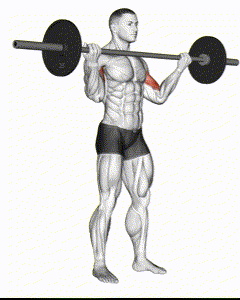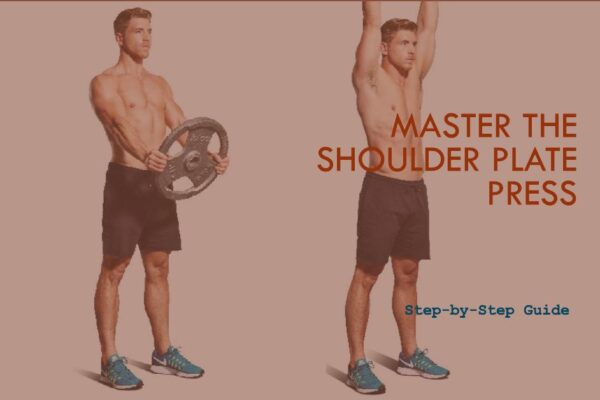Building biceps is a common goal for many fitness enthusiasts, and the wide grip barbell bicep curls exercise is an effective way to achieve that. Wide grip barbell bicep curls are a variation of the traditional barbell curls, where the hands are placed wider apart on the barbell.
What is the Wide Grip Barbell Bicep Curls?
Wide Grip Barbell Bicep Curls refer to a strength training exercise where a barbell is grasped with a grip wider than shoulder-width, and then lifted upward towards the shoulders while keeping the upper arms stationary. This exercise primarily targets the biceps muscles, promoting muscle growth and strength development in the upper arms.

Understanding the Importance of the ide Grip Barbell Bicep Curls
Wide grip barbell bicep curls offer several benefits that make them a valuable addition to any bicep training routine. By utilizing a wider grip, this exercise places greater emphasis on the outer portion of the biceps, contributing to overall bicep development.
Additionally, wide grip barbell bicep curls also engage secondary muscles such as the brachialis and forearm muscles, leading to more balanced and functional arm strength.
Overview of the Article
In this article, we will discuss wide grip barbell bicep curls in detail. We’ll cover the muscles they work, the advantages they provide, how to do them correctly, different ways to perform them, common errors to avoid, workout plans, advanced tips, and frequently asked questions.
By the end of this guide, you’ll have all the information you need to add wide grip barbell bicep curls to your workouts and get the most out of your bicep training.
Muscles Targeted by the Wide Grip Barbell Bicep Curls
- Biceps Brachii: Located on the front of the upper arm, the biceps are responsible for bending the elbow and rotating the forearm. They are the main focus of the exercise and contribute to overall arm strength and definition.
- Brachialis: Situated underneath the biceps, the brachialis muscle helps in flexing the elbow joint. Targeting this muscle along with the biceps can contribute to a more well-rounded arm development.
- Forearm Muscles: The wide grip barbell bicep curls also engage the muscles of the forearms, including the brachioradialis and wrist flexors. These muscles provide stability and assist in controlling the barbell during the exercise.
By engaging these muscles through barbell close grip bicep curls, you can effectively develop and strengthen your biceps, as well as improve the overall aesthetics and functional abilities of your arms.

Benefits of the Single Dumbbell Two-Hand Curl
A. Increased Bicep Activation
- Wide grip barbell bicep curls provide increased activation of the biceps muscles compared to regular barbell curls.
- The wider grip places more tension on the outer portion of the biceps, leading to greater muscle recruitment and overall bicep development.
B. Enhanced Grip Strength and Forearm Development
- Due to the wider grip, wide grip barbell bicep curls require greater grip strength and forearm stabilization.
- Regular practice of this exercise can lead to improved grip strength and forearm development, benefiting various other exercises and daily activities that involve grip strength.
C. Brachialis Muscle Focus
- The brachialis muscle is located underneath the biceps and plays a crucial role in overall arm development.
- Wide grip barbell bicep curls engage the brachialis to a significant extent, promoting balanced and proportional muscle growth.
D. Practicality and Versatility
- Wide grip barbell bicep curls can be performed with a barbell and are suitable for various fitness levels.
- This exercise can be easily incorporated into a bicep training routine, offering practicality and versatility in achieving your fitness goals.
How to Perform the Wide Grip Barbell Bicep Curls
To perform Wide Grip Barbell Bicep Curls correctly, follow the steps below:
A. Proper Set-Up and Equipment Selection
- To perform wide grip barbell bicep curls, you will need a barbell and appropriate weights.
- Start by selecting a weight that challenges you but still allows for proper form and execution.
- Place the desired weights on both ends of the barbell.
B. Step-by-Step Execution Guide
- Stand with your feet shoulder-width apart and grasp the barbell with a wide grip, hands positioned slightly wider than shoulder-width apart.
- Keep your upper arms close to your sides, elbows fully extended, and shoulders back.
- Slowly curl the barbell upward by flexing your elbows while keeping your upper arms stationary.
- Continue curling until your biceps are fully contracted and the barbell is close to your shoulders.
- Pause briefly at the top of the movement, then slowly lower the barbell back to the starting position under control.
- Repeat for the desired number of repetitions.
C. Breathing Technique for Optimal Performance
- During wide grip barbell bicep curls, exhale as you lift the barbell and inhale as you lower it back down.
- Maintaining a consistent breathing pattern throughout the exercise helps stabilize your core and enhances performance.
D. Recommended Repetition Ranges and Sets
- For muscle growth and strength development, aim for 8-12 repetitions per set. Perform 3-4 sets of wide grip barbell bicep curls as part of your overall bicep training routine.
- Adjust the weight accordingly to ensure proper form and intensity.
Variations of the Wide Grip Barbell Bicep Curls
To add variety to your bicep workout and stimulate muscle growth, consider incorporating the following variations of wide grip barbell bicep curls:
Close Grip Barbell Bicep Curls
- Technique and Execution:
- Stand upright with your feet shoulder-width apart and hold a barbell with a grip slightly narrower than shoulder-width apart.
- Keep your back straight, shoulders relaxed, and elbows close to your sides.
- Curl the weight upward, keeping your upper arms stationary.
- Continue the upward movement until your biceps are fully contracted and the barbell is close to your chest.
- Slowly lower the weight back down to the starting position, fully extending your arms.
- Benefits
- Targeted Bicep Activation: Close grip barbell bicep curls focus on the inner portion of the biceps, helping to develop overall bicep size and definition.
- Improved Strength and Muscle Development: This exercise challenges the biceps in a unique way, leading to improved strength gains and muscle development, especially in the inner biceps and brachialis muscle.
- Enhanced Muscle Symmetry: By specifically targeting the inner biceps, close grip barbell bicep curls can address muscle imbalances and improve overall arm symmetry.
Dumbbell Hammer Curls
- Proper Form and Execution:
- Hold a pair of dumbbells with a neutral grip (palms facing each other) and arms fully extended by your sides.
- Keep your elbows close to your body and curl the dumbbells towards your shoulders.
- Lower the dumbbells back down in a controlled manner.
- Benefits:
- Balanced Muscle Development: Hammer curls target not only the biceps but also the brachialis and brachioradialis muscles, contributing to overall arm symmetry and strength.
- Forearm Development: The neutral grip engages the forearm muscles, promoting forearm strength and stability.
- Joint-Friendly Alternative: Hammer curls can be a suitable option for individuals with wrist discomfort or limitations.
Read: Shape Your Arms with Bicep Hammer Curl
Cable Rope Hammer Curls
- Proper Form and Execution:
- Attach a rope handle to a cable machine set at a low pulley.
- Stand facing the machine with a slight forward lean.
- Grasp the rope with a neutral grip, palms facing each other.
- Keeping your elbows stationary, curl the rope handles towards your shoulders.
- Slowly return to the starting position.
- Benefits:
- Constant Tension: Cable resistance provides continuous tension throughout the movement, maximizing muscle stimulation and recruitment.
- Increased Range of Motion: The cable allows for a greater range of motion, enhancing the stretch and contraction of the biceps.
- Core Stabilization: The standing position engages the core muscles, promoting stability and balance.
Preacher Curls
- Proper Form and Execution:
- Here is how to perform preacher curls.
- Sit on a preacher bench and position your upper arms on the angled pad.
- Grasp the barbell with an underhand grip, shoulder-width apart. Keeping your upper arms on the pad, curl the barbell upwards.
- Slowly lower the barbell back down with control.
2. Benefits:
- Below are the benefits for preacher curls
- Isolated Bicep Focus: Preacher curls isolate the biceps by minimizing involvement from other muscles, allowing for a targeted bicep workout.
- Reduced Cheating or Swinging: The preacher bench restricts excessive body movement, promoting strict form and reducing momentum.
- Elbow Stability: The preacher bench provides support for the elbows, reducing stress on the joint and allowing for a more controlled movement.
Read: Mastering the Preacher Curl: Your Ultimate Guide to Bigger Arms
Incorporating these variations into your workout routine can provide a well-rounded approach to bicep training, targeting different angles and muscle groups for comprehensive arm development.
Common Mistakes to Avoid in the Single Dumbbell Two-Hand Curl
To get the most out of barbell close grip bicep curls, it’s crucial to avoid these common mistakes:
A. Using momentum
- Avoid swinging or using momentum to lift the weight. Focus on controlled and deliberate movements to fully engage the biceps.
B. Lifting too heavy
- Choose a weight that allows you to maintain proper form and execute the exercise with control.
- Lifting excessively heavy weights can compromise your technique and increase the risk of injury.
C. Poor grip
- Ensure a firm and secure grip on the barbell throughout the exercise. This helps maintain stability and prevents the barbell from slipping
D. Rounding the back
- Keep your back straight and maintain proper posture throughout the exercise.
- Avoid rounding your back or hunching over, as this can lead to unnecessary strain on the spine.
E. Neglecting full range of motion
- Perform wide grip barbell bicep curls through a full range of motion.
- Lower the weight fully, allowing your arms to fully extend, and then curl the weight up as high as possible to maximize muscle activation.
Wide Grip Barbell Bicep Curl Workout Routine
To incorporate wide grip barbell bicep curls into your workout routine effectively, follow these guidelines:
A. Proper Warm-up Exercises
- Before starting your wide grip barbell bicep curl workout, it’s essential to warm up your muscles and increase blood flow to the targeted area.
- Perform a few minutes of light cardio, such as jogging or cycling, followed by dynamic stretches and arm circles to warm up the shoulders and biceps.
B. Recommended Sets, Repetitions, and Rest Periods
- For optimal results, perform 3-4 sets of wide grip barbell bicep curls, aiming for 8-12 repetitions per set.
- Rest for approximately 60-90 seconds between sets to allow for adequate recovery.
C. Incorporating Progressive Overload
- To continue challenging your muscles and promoting growth, gradually increase the weight or repetitions over time.
- Progressive overload is key to stimulating muscle adaptation and achieving ongoing progress.
D. Tracking and Measuring Progress
- Keep a workout journal or use a fitness tracking app to record your sets, repetitions, and weights used for wide grip barbell bicep curls.
- This allows you to monitor your progress and make adjustments to your routine as needed.
Advanced Techniques and Tips for Maximum Results
1. Supersets and Drop-sets
- Incorporate supersets and drop-sets into your wide grip barbell bicep curl workout routine to intensify the training stimulus.
- Supersets involve performing two exercises back-to-back without rest, while drop-sets involve gradually decreasing the weight as you reach muscle fatigue.
2. Isometric Holds and Slow Eccentric Contractions
- During wide grip barbell bicep curls, include isometric holds at the peak of the curl and slow eccentric contractions during the lowering phase.
- Isometric holds involve holding the contracted position for a few seconds, and slow eccentric contractions involve lowering the weight slowly and under control.
- These techniques enhance muscle tension and promote muscle growth.
3. Peak Contraction Techniques
- At the top of each repetition, squeeze your biceps and hold the peak contraction for a brief moment.
- This maximizes muscle activation and enhances the mind-muscle connection.
4. Dynamic Grip Variations
- Experiment with different grip variations, such as a pronated (overhand) grip, supinated (underhand) grip, or a neutral grip, to target the biceps from different angles and stimulate muscle growth.
Frequently Asked Question
By addressing the following frequently asked questions, we hope to provide clarity and guidance on incorporating the Wide Grip Barbell bicep curls into your fitness routine. Remember to listen to your body, start at an appropriate level, and gradually progress for optimal results.
Conclusion
wide grip barbell bicep curls are a valuable addition to any arm workout routine. By targeting the biceps, brachialis, and forearms, these curls help build strength and promote muscle growth. With proper form, gradually increasing weights, and consistency, you can achieve impressive results.
Remember to incorporate variations and other exercises to ensure a well-rounded arm training program. So, embrace the challenge, stay committed, and enjoy the rewards of bigger and stronger biceps with wide grip barbell bicep curls.
Don’t wait any longer, start curling today and witness the transformation in your arm muscles.






Leave a Reply